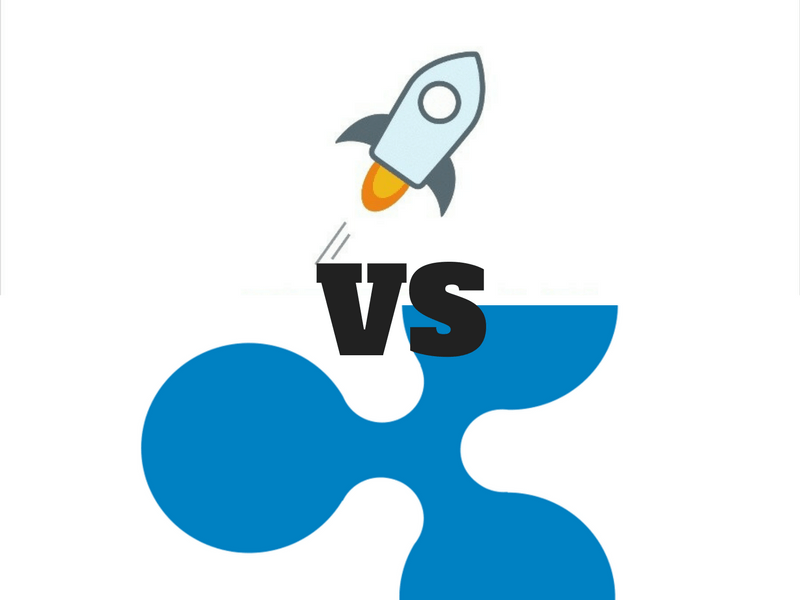
Stellar Lumens or XLM has been soaring up since last Christmas day, and only in the past 24 hours, it’s been up another 65%, approaching the $1.00 level versus the USD. If you look closer you will see that Stellar Lumens is very similar to Ripple (XPR). There are things that certainly connects them; they are both founded by Jed McCaleb. They are both in business of underlying payment processing solutions with native assets.
But if you look really close, you are going to find more differences than similarities. Hard fork in Ripple protocol in 2014 resulted in Stellar and Stellar Development Foundation. The fork led to a creation of a new and fundamentally different entity from Ripple. Team behind Stellar says that they have fixed some issues that Ripple had, but in general there seems to be a divisions in business models.
What are the difference between these two companies? The root of the answer lies in the business models of the respective companies.
What you'll learn 👉
Business Model Differences

Stellar.org is the nonprofit organization that contributes to the development of tools and social good initiatives around the Stellar network and financial inclusion. Employees contribute code to the Stellar network, but the technology is independent of the organization. Stellar is a distributed, hybrid blockchain that is fully open-source. It is infrastructure that exists to facilitate cross-asset transfers of value, including payments. With just one integration into the Stellar Network, you will join an open, global financial network where all actors – be they people, payment networks, or banks – have equal access & economic participation.
According to its website, “Stellar.org connects people to low-cost financial services to fight poverty and develop individual potential.” Based on its mission, its classified as a non-profit organization.
Stellar.org covers operational costs in several ways:
– 5% of the initial lumens are set aside for operational costs.
– Stellar.org accepts tax-deductible donations from the public.
They received an initial infusion of funding from the payments startup Stripe. Their corporate donors include BlackRock, Google.org, and FastForward.
Stellar announced a landmark partnership with IBM on October 16. This deal includes not only IBM but also a network of banks who will use Stellar to move money across borders. IBM is now running 8 Stellar nodes and has set up 12 currency corridors in Australasia and Oceania.
In addition to closing the deal with IBM, Stellar has grown its partnership network worldwide.
Tempo, a France-based money transfer company, deserves a special mention here. In them, Stellar added a critical bridge to the existing fiat world, as they now serve as a EUR anchor. Transaction volume along the corridor Stellar is most focused on, Europe to Philippines, increased dramatically in 2017 and continues to grow. Volume today is roughly 20x what it was just three months ago.
Ripple, on the other hand, connects banks, payment providers, digital asset exchanges and corporates via RippleNet to provide one frictionless experience to send money globally. Ripple is a for-profit entity that is creating a payments network with large financial institutions. It currently has over 75 big banks on its network, including big names like Bank of America, RBC, Standard Chartered, and UBS. Ripple wants all banks to perform settlements on the Ripple network. It’s unclear whether there are live payments on Ripple yet — larger banks tend to be a much more conservative batch, and it’s possible that some will branch off to build their own technology and networks. Oh yes, XPR system is a closed source, which means that general public cannot change it or look at it.
Technical Distinction

After the split in 2014, Stellar and Ripple shared almost a same code. But now there is almost no similarities in shared code (though there may be some shared semantics).
A year later, SDF presented a brand new payment system protocol called “Stellar Core”. That lead into a new spin on consensus algorithms with the Stellar Consensus Protocol (SCP). SCP enjoys open membership that promotes organic network growth. Compared to decentralized proof of-work and proof of stake schemes, SCP has modest computing and financial requirements, lowering the barrier to entry and potentially opening up financial systems to new participants. The Stellar Consensus Protocol was developed by David Mazieres, Professor of Computer Science, and is biased towards safety and correctness at the expensive of liveness.
SCP’s safety is optimal for an asynchronous protocol, in that it guarantees agreement under any node-failure scenario that admits such a guarantee. SCP is free from blocked states – in which consensus is no longer possible – unless participant failures make it impossible to satisfy trust dependencies.
SCP is the first provably safe consensus mechanism to enjoy four key properties simultaneously:
- Decentralized control. Anyone is able to participate and no central authority dictates whose approval is required for consensus.
- Low latency. In practice, nodes can reach consensus at timescales humans expect for web or payment transactions—i.e., a few seconds at most.
- Flexible trust. Users have the freedom to trust any combination of parties they see fit. For example, a small non-profit may play a key role in keeping much larger institutions honest.
- Asymptotic security. Safety rests on digital signatures and hash families whose parameters can realistically be tuned to protect against adversaries with unimaginably vast computing power.
The Ripple protocol, on the other hand, uses a “Proof of Correctness” consensus mechanism. The Ripple Protocol consensus algorithm (RPCA), is applied every few seconds by all nodes, in order to maintain the correctness and agreement of the network. Once consensus is reached, the current ledger is considered “closed” and becomes the last-closed ledger. Assuming that the consensus algorithm is successful, and that there is no fork in the network, the last-closed ledger maintained by all nodes in the network will be identical.
You can find more technical differences on the Bitcoin Stack Exchange, here are some of the most interesting:
- Stellar is explicitly inflationary, with 1% new coins being created every year and all fees being recycled, while ripple destroys fees, meaning the total number of ripples in existence is slowly diminishing over time.
- Stellar uses the Ed25519 signature scheme (basically Schnorr) and 32-byte public keys as addresses, while ripple uses ECDSA and 20-byte hashes as addresses.
- At the implementation level, Stellar’s protocol is specified using Sun XDR, whereas Ripple uses a combination of Google protobufs and hand-written marshaling code.
Stellar is considered more decentralized than Ripple. For instance, in 2015 there was a controversy around Ripple as the funds of departed founder McCaleb were blocked. It demonstrated that Ripple has some level of control over their network. If they have any kind of control over their network than this goes against a basic idea of blockchain.
Soon enough, the company published a denial. Company’s CEO Brad Garlinghouse stated on Quora: “Ripple is not centralized. To be clear, if Ripple disappeared today XRP would continue to function. To me, that’s the most important measure of whether something is decentralized.”. On the other side, Stellar never faced the discussion whether it is centralized or decentralized. Despite that, it is always easy to make an argument about centralization.
For instance, developer at Ethereum who can decide to reverse transactions (the DAO) or make any other amends on the network and everyone will do the same. Some form of centralization can be found at Bitcoin, where group of people control the mining power.
Stellar Development Foundation is in the control of huge share of Lumens which in theory could give them centralized power. At the time being, Stellar is a safer bet than Ripple when it comes to question about centralization.
Different Cultures

These two companies have very different cultures. Ripple has raised over $93.6 million, and that has translated to a team of over 200 employees. By comparison, SDF has raised $3 million from Stripe at its inception. SDF’s new for-profit implementation arm, Welcome, has raised maybe $2.5 million. There are around 20 employees, but they’re all extremely smart and credentialed (rockstar engineers, amazing advisors, much of the team from MIT, Stanford, and Harvard, people well-versed in international finance, and more).
Stellar does not have as much of a marketing and PR machine behind them. Unlike Ripple, who used share of their capital to make Ripple a household name and make some publicity.
In general, Stellar has created a welcoming environment for 3rd party developers. Additionally, they have also created events such as The Stellar Build Challenge. It is an ongoing program to reward innovation and development in the Stellar ecosystem. They are looking for entries that satisfy the three guidelines:
- Return Submissions. Don’t let your projects die! Stellar love to see how previous entries improve as time progresses. They are looking for projects that are under continual development and grow as the Stellar community grows.
- Contribution to existing projects. If you are new to the build challenge, but you don’t know where to start, the Stellar is a good place to start and they are willing to award those who help out with previous Stellar-based projects.
- Design. They are die hard fans of well designed, responsive, functional projects, and they want to let people know that they think your hard work looks amazing.
Ripple is going after big banks, while Stellar is going after individuals. Stellar also focuses less on big brand banks and more dedicated to smaller money transfer operators. Ripple, on the other hand, has a huge team, lots of capital, and is generating a lot of publicity with big name partnerships.
Different Partnerships

In October 2017, Stellar announced that it is partnering with IBM and KlickEx to develop a blockchain-based cross-border payments solution proven to significantly reduce transaction costs and increase transaction speeds. This solution will help financial institutions and consumers eliminate inefficiencies and frustrations in current cross-border payment systems, including high fees, slow processing, error-prone transactions, and inefficient capital utilization. Stellar’s technology serves as the core backbone of this cross-border payments solution.
The partnership is a part of the Hyperledger Fabric Project and under it a network of banks will process transactions using Lumens. They will put their trust into local market makers to convert the Lumens into local traditional currencies.
This cross-border payments solution is already processing live transactions in 12 currency corridors across the Pacific Islands and Australia, New Zealand and the United Kingdom.
In November 2017, CNBC announced that American Express, Santander teamed up with Ripple to speed up cross-border payments between the U.S. and the U.K. by using blockchain technology. Payments made by American Express’ business customers on its FX International Payments (FXIP) platform will now be routed through Ripple’s enterprise blockchain network, RippleNet. American Express’ blockchain project will initially allow customers in the U.S. to connect instant, traceable cross-border non-card payments to U.K. Santander bank accounts.
All of these projects are great progresses, but there also some questions marks like will the banks want to use the XRP token? If they decide not to, what does it mean for the Ripple?
Conclusion
The latest market cap of the Ripple is $30 billion, while Stellar is around $7 billion. It is important to point out that Ripple’s market cap fell from $148 billion recorded at the beginning of January 2018, while the Stellar’s market cap fell from $16 billion at the same period.
This gap between the two is a result of al the difference we discussed here. Besides the fact that they are similar and coming from the same original protocol, we have to keep in mind that they serve different markets. Therefore they are not direct competitors.








